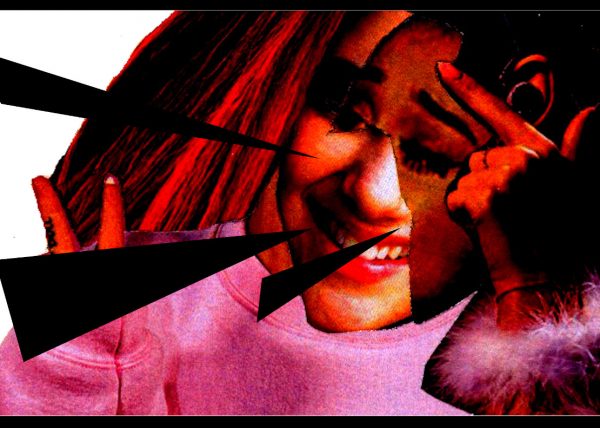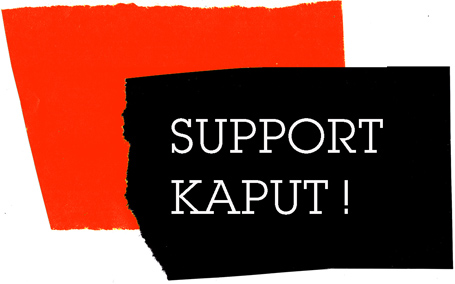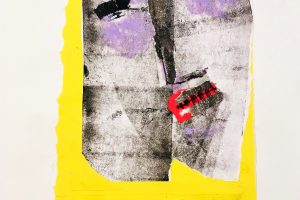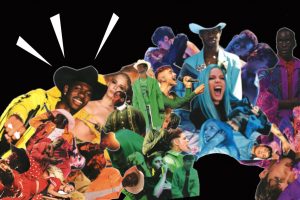ARIANA GRANDE AND “BLACKFISHING” – WHERE DOES RACISM BEGIN?
Are the kids alright? And are we? In August, three authors are reflecting on current phenomena in youth culture – and what they mean for the present. To kick off the series, ARIANA ZUSTRA examined a trend that many consider unacceptable: “black fishing”. White artists like Ariana Grande are accused of styling themselves and acting like black people. Where does style and homage end and where does racism begin?
Illustration: RONJA SEIFERT.
Ariana Grande has a problem. The 26-year-old is a teen idol, the woman with the most subscriptions on Instagram and one of the most successful pop stars of the present. But the Internet thinks her style is racist.
German tabloids such as Gala classify Grandes Look flapsy as a “self-tanning accident”. US media were more aware of the problem: they accused the singer of “blackfishing”. The term describes a relatively new strategy in pop culture: white people put on make-up, style and present themselves like black people in order to gain attention and reach. The intention is to please a black audience with an acquired “coolness” and “street credibility” – “fishing for black people” so to speak.
With the help of bronzers, make-up, clothing and not least cosmetic surgery, white artists and internet stars want to evoke the impression that they have African, Arabic or Hispanic roots. The user @thomeography wrote on Twitter: ” […] Ariana Grande is starting look more & more… bronzed… like, sis is really trying to give us Afro-latina and it’s messy & creepy. Very minstrel-esque.”
In the 18th and 19th centuries, minstrel shows were a popular form of theater in the United States, where whites put on dark makeup in a caricaturing way and portrayed black people as fools using racist stereotypes. Many characterize blackfishing as a modern version of this masquerade called blackfacing.
So, is one of the greatest pop singers of our time a racist?
On social media, people agree that Ariana Grande is part of a culture to which she doesn’t belong. The daughter of Italian immigrants is a white woman from Florida who is mistaken for being Latina because of her look – and obviously wants to be. Grande triggers shitstorms on Twitter, numerous before-and-after pictures show how much the R’n’B star has changed over the years: At the beginning of her career, the singer was still a pale, discreetly made-up girl with red-coloured hair. As time went by, her complexion became darker and darker, her make-up stronger and her lips fuller. When Grande performed her song “Side to Side” at the MTV Video Music Awards 2016 with rapper Nicki Minaj, who has Afro-Trinidadian and Indo-Trinidadian roots, Grande was the one with the darker complexion. Some viewers wondered: How is that possible?
Grandes transformation is not just about a questionable preference for a tanning, or about questions of taste in beauty at all. It’s about the fact that some people of color see Ariana Grandes’ appearance as a racist act that they regard as a form of cultural appropriation. In cultural appropriation, traditional objects, codes, or characteristics of an ethnic group are instrumentalized. In Grandes’s case: to make money, as many people assume. She is accused of only taking over those parts of an oppressed minority that can be well marketed, and thus of discrediting the already disadvantaged supporters of this community.
Grandes’s changed appearance is only one aspect of a transformation she has undergone in recent years: from pop to hiphop. Hiphop is currently the most popular genre among teenagers and has gone from subculture to mainstream. Anyone who wants to make money in the music industry takes a piece of the hiphop cake.
So it’s hardly surprising that the music of the former Disney star now sounds more like trap than pop. In her hit “7 Rings” she raps about money, bitches and her ass. The music video shows Momma Grande with her girls in a pink villa and with big cars, and overall the gangsta aesthetic bubbles out of every champagne glass so clearly that some scold “plagiarism!” The US rapper Princess Nokia, who hails from Puerto Rico, accused Grande of cribbing her song “Mine”, the African-American rapper Soulja Boy demanded royalties on Twitter because he could hear parallels to his single “Pretty Boy Swag”. Grande kept quiet about it.
But not only the way she was singing recently is being hold against her – but also the way she is speaking. In a YouTube video from Billboard magazine on December 5, 2018, the singer comments on photos from her childhood. Looking at a picture of her sitting on her grandmother’s lap with bottles and cookies in her hand, she says: “Bitch, that’s my cookie. That’s my juice. Okay?” In an Instagram clip Grande purrs with rolling R: “C’mon girl, getcha ass in here!” In the ears of many viewers this sounds suspiciously like “Blaccent”, like a slang used mostly by Afro-American teenagers.
Ariana Grande is by no means the only one accused of blackfishing. Evil tongues claim that Australian rapper Iggy Azalea has built her entire career from set pieces of black culture, from music to performance. The blonde has even had her body operated more fully presumably with butt implants, as they were brought into fashion by the Kardashians.
Not only women in the pop business, but also numerous models and network personalities are blamed for racism. The best-known example is Emma Hallberg, a Swedish instagramer with 287,000 subscribers. She stages herself with voluminous curls, pouty lips, an artificial tan and streetwear as kind of a mixed-raced hot chick. She replied to a skeptical follower in a private message that she would just get very tanned in the summer.
The big question is: Is there really a problem here – or is it being created?
Not an easy question. The Canadian pop journalist Wanna Thompson, for example, thinks: “Yes, there is definitely a problem.” She set the ball rolling when she wrote a tweet on November 7, 2018 that went viral: “Can we start a thread and post all of the white girls cosplaying as black women on Instagram? Let’s air them out because this is ALARMING.” The message was shared 22,500 times. ” So many beautiful, and talented black girls struggling to hold views on YouTube and brands rather sponsor our “imitations”? Just how sway?” replied @_blackaida. And @Valentinaxoxo wrote: ” Truth is, people wanna be black without any of the consequences. At the end of the day, they get to take out their “natural” hair extensions and wash the brown off, but true women of color can’t. That sounds a lot like privilege to me.”

Vogue Juli 2018
On the July 2018 cover of the British Vogue, Ariana Grande again appeared pale, blonde colour with freckles – because, unlike people of colour, she has the choice. In other words: For the shady music video she mimics the sexy Latina, for the glossy magazine she shows lividity again.
Due to the act of blackfishing, “being black” deteriorates into an accessory that white people can put on and take off as they like, without being able or having to empathize with the disadvantages that people of color are exposed to. Considering the oppression and discrimination that people experience all over the world because of their skin color, it is understandable that people of color consider this trend insensitive and cynical.
The German YouTuber Liza Cole sums up the problem in a video as follows: “The first thing that comes to mind when you think of a black woman: thick lips, thick bottom, curves. […] When a white woman takes over these features, it’s celebrated on her, especially nowadays, as it’ s trendy. In the late naughts, I was often told that my lips or ass were too fat. They said I was ugly. […] This is what makes black women in Germany and the US so angry: All of a sudden girls, who are blackfacing, are doing the same thing, but they are being celebrated for it!”.
The activist Rebekah Hutson found even more drastic words on her blog “OnlyBlackGirl”: “It’s not just us wanting to hoard our cultures for ourselves, It is the fact that white people want to take the parts of black they like while simultaneously getting rid of black people. Same applies to every other ethnic group y’all love to appropriate. It’s cultural genocide.”
So the facts are clear – and everyone knows what is good and what is bad, the do’s and don’t’s. Correct? Wrong. Or rather: Hard to say.
The debate about cultural appropriation suffers from its premise: It is based on the assumption that culture is something original that one can or cannot have. But the reality is different: Culture is nothing self-contained. There are therefore also no “cultural circles”, since the circle metaphor implies that every “culture” is a round thing, divisible into an inside and an outside, clearly separable from another. However, “culture” is always in motion, changes, permeates lifestyles, all over. Everything repeats itself, everything resembles itself. In the tradition of Humboldt, one can say that everything is connected with everything. What is seen as “own” and what is seen as “foreign” is always a construct and not given by nature. (A thing that nationalists unfortunately do not understand.)
Cultural appropriation is a much discussed, complex topic in pop culture. In many debates, however, the term restricts the view rather than being able to comprehensively describe reality. As a concept it is mainly used pejoratively these days.
But the history of the world is the history of cultural appropriation. The Romans shaved their hair to look like Greeks, the Egyptian women bleached their hair to look like Germanic women. Italian pasta is quasi cultural appropriation: pasta originally comes from China. And the very, very German potato comes from South America. Of course, these are imported goods, but the point is that they are also things that were not always “there”, but today are perceived as belonging to a very specific culture.
Pop is cultural appropriation. Especially in our globalized, digitized world. The borders between genres in music have been dissolving for years – who can tell exactly which style comes from where? According to the abovementioned view, one can also accuse Elvis Presley or the Beatles of cultural appropriation, because they refer to jazz and blues, in the case of the Beatles also to traditional music from India. And quite a few accuse them of exactly that. But it is this experimentation with different influences that has made the Beatles the biggest and most innovative band of all time. In conclusion, who can claim to know who started where with which practice? There is always a group of people who did something “first”. But it becomes problematic where appropriation is not an exchange, but a one-way street. Where oppressors draw on the oppressed.
But who has the sovereignty to interpret when something is hurtful and with which consequences? Should Ariana Grande and other women be forbidden to act as they please? What in Ariana Grande’s art is an influence, what an homage, what a takeover? When do make-up and self-tanners make a white girl look so dark that it’s racist?
The debate about blackfishing has the same problem as the concept of cultural appropriation: it implies that “black culture” is something uniform, fixed, diametrically different from “white culture”, and held by all blacks. In the majority-German discourse it is now agreed on that there is no such thing as “the Islam”, or “the women” or “the men”. In the case of “the blacks”, however, generalization is sometimes as strong as if it were a homogeneous mass that always shares the same views and feelings – for example on the topic of blackfishing.
Like every culture, “black culture” was inspired by other cultures. Dreadlocks, for example, are considered typically Afro-American, and there are regular arguments about whether whites are racist when they wear this hairstyle. The felt curls have their origin with the Rastafari of Jamaica, and these in turn refer to the Nazarites from the Old Testament.
There is no distinct “black” or “white” culture, no “Turkish” or “Syrian” culture, that “has always been there”, that is “authentic” per se and therefore could be protected from outside influences and takeovers. To argue so is segregating. And theories like “That’s the way it is”, or alternatively: “It has always been this way”, or “That’s the way ‘we’ are, and this is the way ‘the others’ are” should basically be challenged by everyone – both in politics and in pop music.
Those white people who want to protect black people from racism in anticipatory obedience often expose the fact that it is them who perceive black people as “the others” and thus always reproduce their “otherness”. This text is also stuck in the dilemma that in writing about “white people” and “black people” two complementary categories are marked – while at the same time it would be unrealistic to deny the differences.
There is never a neutral or objective way of talking about an “other” because what is perceived as the “other” is already based on attributions. It is encroaching to speak for or about a group. For this reason, this text only quotes voices of people of color. Even if each one of them actually can only speak for themselves.
How can the problem concerning Ariana Grande be solved?
We don’t know what the true grand intentions behind Grande’s image change are, how much she values “black culture” and supports its supporters. There is at least one indication: According to her black co-writer Tayla Parx, Grande always pays attention to giving her colleagues of color the laurels they deserve. Moreover, it can be said in Grande’s defense that she never explicitly claimed to be black or Hispanic. And who can prove that the artist doesn’t choose her music and look out of pure preferences?
“Culture” is something mutable, skin color is not. Is it still possible to interpret blackfishing in an appreciative way? After all, young people have always emulated their idols out of admiration, even optically. If this trend is needed in order to sensitize them to racism, it would at least have a positive effect.
Perhaps it is less relevant whether someone adopts something culturally rather than how it is done: exploitative or value-adding? Respectful or hurtful? Superficial or reflected? Open-mindedness and communication are needed to discuss this. As long as black people in society are not treated exactly like white people, with the same chances and the same participation, white people need to be aware that they are in a position of power – whether they want to recognize it or not. Everything that white people perceive in the world is shaped by their whiteness. And those who are being inspired by another community are well advised to be aware of the history and needs of its members – and not just to copy a style naively.
Instead of limiting white people’s approach to a “black culture”, the objective should be to ensure that black people are not discriminated against because of their culture and skin colour. Instead of curtailing the privileges of the privileged, everyone should contribute to ensuring that all people have equal rights and opportunities. And as long as this is not yet the case, the privileged have to listen to the less privileged – including in debates about appropriation processes. In order to continually discuss where there is inequality and how we can overcome it. So that everyone can live freely.
Text: Ariana Zustra // Illustrationen: Ronja Seifert // Kuratiert von: Julia Lorenz
Translation by Denise Oemcke.
















